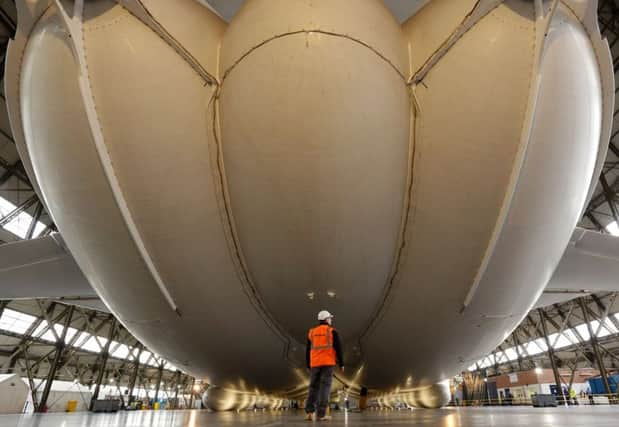Alastair Dalton: New age of the airship about to take off?


The giant airship-looking Airlander 10 - which is also part aircraft, part helicopter - is due to resume test flights following a damaging “heavy landing” on one of its first flights last August.
Despite being based at the historic former Royal Airship Works at Cardington, near Bedford, many of the company’s key people behind the 300ft-long craft are Scottish.
Advertisement
Hide AdAdvertisement
Hide AdLed by chief executive Stephen McGlennan, from Stepps in North Lanarkshire, Hybrid Air Vehicles also includes chief test pilot David Burns from Rutherglen in South Lanarkshire, and head of flight science David Stewart from Dunblane. Company chairman Philip Gwyn is the grandson of Clyde shipbuilding magnate Hugh Macmillan.
The firm wants to transform cargo and luxury air travel with what they describe as the quietist, greenest and longest-range flying machine.
The team have made further bold claims, such as the Airlander being cheaper, faster and less polluting on short-haul routes than existing aircraft, able to stay airborne for up to five days.
In short, the craft could usher in a new golden age of airships - a technology largely abandoned since its heyday in the 1920s and 1930s.
But despite Airlander 10’s huge size, the length of a football pitch, its somewhat bumpy early forays aloft also reflect a degree of fragility, just like its far larger predecessors which emerged from the same gigantic sheds 90 years ago.
Airbags have been added since last year’s nosedive so Airlander can land at a greater range of angles. Then on Wednesday, the company issued a statement to counter reports about the craft “nosediving” and “breaking free of its mooring lines”, having been tethered to the ground since re-emerging from its shed nearly two weeks ago.
It clarified that Airlander had “pitched up at the rear by a small amount”, which it said was normal, and the craft remained attached to its mooring mast.
The sensitivity over such unfamiliar manoeuvres characteristic to airships has echoes of a forthcoming book about one of Airlander’s most famous Cardington antecedent - the 777ft-long R.101 - which was destroyed by fire after crashing in France on its maiden voyage to India in 1930.
Advertisement
Hide AdAdvertisement
Hide AdFatal Flight - The True Story of Britain’s Last Great Airship by Bill Hammack, which is published in June, relates in vivid detail the extreme care needed to handle R.101 (R for rigid).
Aside from the explosive danger from being filled with hydrogen, unlike Airlander’s inert helium, R.101’s shell that encased its gas bags were made from the intestines of 25,000 cattle, which ripped during test flights.
Hammack relates how the airship was also rushed into service because of political pressure to show off a new symbol of Britain’s imperial might. He said its “undignified” end led to the country never building or flying one again.
The book also mentions Scotland’s part in airship history, such as R.34’s successful crossing from East Fortune in East Lothian - now the National Museum of Flight - to the United States in 1919, and Germany’s Graf Zeppelin’s visit a decade later.
With the reputation of the modern-day successor to these leviathans of the air at stake - and with it Scottish ingenuity, all eyes will be on Airlander when it takes to the skies again.